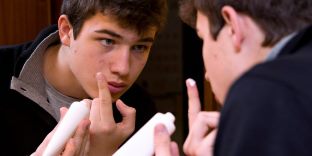
 Acne is one of the most common skin conditions we see in Dermatology. It affects predominantly teens and adolescents; however it can develop later in life as well. Aside from the obvious physical symptoms of acne; blackheads, whiteheads, inflamed cysts, redness, scarring and even pain, acne also carries with it psychosocial effects. Effects such as, issues with self-image, difficulty with interpersonal relationships, and even an increased propensity for depression and anxiety. All of which can be carried with the individual throughout their entire life. Even so, it is a skin disorder that is all too often dismissed as ‘just some acne’ and ‘not a big deal’. However, it very well can be a big deal for those living with acne day in and day out. Therefore, I think it is extremely important to treat acne on a personalized basis which is tailored to the individuals’ type of acne and their particular expectations/desires. In order to do so, we must first understand what acne is.
Acne is one of the most common skin conditions we see in Dermatology. It affects predominantly teens and adolescents; however it can develop later in life as well. Aside from the obvious physical symptoms of acne; blackheads, whiteheads, inflamed cysts, redness, scarring and even pain, acne also carries with it psychosocial effects. Effects such as, issues with self-image, difficulty with interpersonal relationships, and even an increased propensity for depression and anxiety. All of which can be carried with the individual throughout their entire life. Even so, it is a skin disorder that is all too often dismissed as ‘just some acne’ and ‘not a big deal’. However, it very well can be a big deal for those living with acne day in and day out. Therefore, I think it is extremely important to treat acne on a personalized basis which is tailored to the individuals’ type of acne and their particular expectations/desires. In order to do so, we must first understand what acne is.
Acne is a multifaceted skin disorder that involves several variables; excess of sebum (oil) production associated with hormonal changes, clogging of pores from abnormal desquamation of follicular keratinocytes, presence of bacteria (Propionibacterium acnes), and overall inflammation. There are different forms and severity of acne such as, comedonal, cystic, or a combination of both, and it can present as mild, moderate, or severe. Therefore, depending on the individuals’ type and severity of acne, the treatment regimen will vary.
When looking at the treatment of acne, the first step for mild-moderate comedonal acne is typically reserved for topical treatment. Topical medications for acne will include a combination of retinoids, topical antibiotic, and/or benzoyl peroxide. The decision of which combination of topicals to use will be based on a number a variables including the type of skin (dry or oily), and the type of acne:
- Topical retinoids work by acting on the skin cell life cycle, and essentially increase the rate at which newer skin cells come to the surface of the skin and older skin cells are exfoliated. By doing so it helps keep pores unclogged by reducing hyperkeratinization which form blackheads.
- Topical antibiotics work by reducing the amount of bacteria contributing to acne that is present on the skin. When using topical antibiotics they should always be used in combination with a topical benzoyl peroxide in order to prevent antibiotic resistance. If used without benzoyl peroxide the bacteria will develop resistance in as early as two weeks of treatment. Benzoyl peroxide also has the added benefit of reducing the amount of oil present on the skin.
In regards to acne that is more severe or is more inflammatory and cystic, it is not uncommon to add in an oral medication. Oral medications will typically include antibiotics, Spironolactone, or Isotrentinoin (more commonly known as accutane):
- The antibiotics that are most often used in the treatment of acne are tetracyclines, such as Doxycycline and Minocycline. These medications are not necessarily being utilized for their antibacterial effects, but rather their anti-inflammatory
effects. The dose and duration of therapy can vary from patient to patient, however, they should always be used in combination with a topical regimen. The idea is to control the inflammation in the acute phase of treatment with an oral antibiotic, while using a topical regimen that will work on prevention of futurebreakouts. Once breakouts and inflammation are under control, the oral antibiotics will typically be discontinued and the topical regimen will be the mainstay of treatment moving forward. - Spironolactone is an interesting medication, in that it is used off label in Dermatology for the treatment of female hormonal acne. It was originally intended to be used as a blood pressure medication, however when used at lower doses it can have a profound effect on hormonally driven acne in females. It works by blocking the testosterone receptors in the chin strap distribution of the face, however it can take up to 3 months of therapy before the benefits are seen. Spironolactone should also be used with a combination of a topical regimen in order to maximize results.
- Isotrentinoin is an oral medication that is reserved for severe nodulocystic scarring acne, or acne that is resistant to treatment. It is the most effective medication that we have for the treatment of acne. So effective in fact, that when using Isotrentinoin there is no need for a topical treatment regimen. This medication is weight based, (meaning the dose used is dependent on how much the individual weighs) and titrated to a dose that is considered a therapeutic level, over about a 5 month duration. Once the therapeutic level is achieved and the breakouts have ceased, the medication is discontinued. Approximately 85% of patients who complete the course will never have another significant breakout.More information on each of these medications including, potential side effects, safety and efficacy, and medication monitoring will be included in the next series on Acne.
[/vc_column_text][/vc_column][/vc_row]


